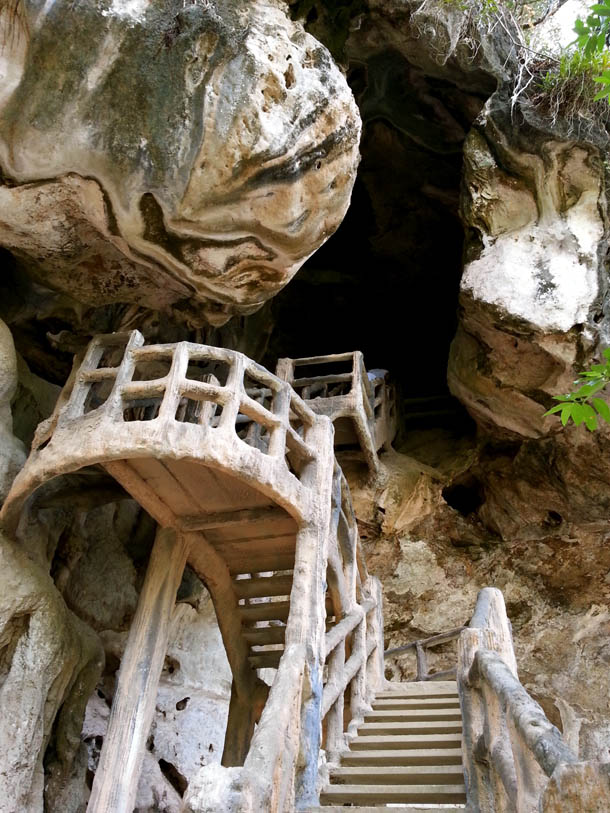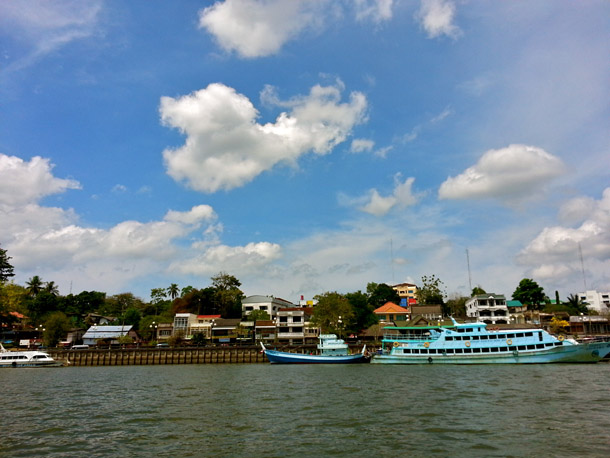 Taking a slight detour from the previous food posts of my Thailand trip, this is a breather post so that all the Thai food that I had been talking about in my earlier posts can settle down. Permanently, in my senses! It was the last day of our inspiring stay in Koh Klang island, the small fishing village in the Krabi region of South Thailand. After breakfast, we all arrived in Baan Ma-Yhing restaurant, the same floating restaurant where we had our elaborate lunch the previous day. This was also the same restuarant where Debbie, my blogger friend from Dubai who had accompanied me for the Thailand Academy trip, and I had come back for our Thai cooking lessons with Bao, the restaurant cook. Checking out from the eco resort that we had been staying in Koh Klang, our luggage had a different itinerary chalked out than ours – they were to be transferred directly to the beach resort that we would be staying in the Krabi mainland. Our itinerary on the other hand, included kayaking in the Krabi river amongst the mangroves, Krabi sightseeing, a lunch break at Kotung restaurant where we tasted Thai Chinese food and finally a Thai Spa experience!
Taking a slight detour from the previous food posts of my Thailand trip, this is a breather post so that all the Thai food that I had been talking about in my earlier posts can settle down. Permanently, in my senses! It was the last day of our inspiring stay in Koh Klang island, the small fishing village in the Krabi region of South Thailand. After breakfast, we all arrived in Baan Ma-Yhing restaurant, the same floating restaurant where we had our elaborate lunch the previous day. This was also the same restuarant where Debbie, my blogger friend from Dubai who had accompanied me for the Thailand Academy trip, and I had come back for our Thai cooking lessons with Bao, the restaurant cook. Checking out from the eco resort that we had been staying in Koh Klang, our luggage had a different itinerary chalked out than ours – they were to be transferred directly to the beach resort that we would be staying in the Krabi mainland. Our itinerary on the other hand, included kayaking in the Krabi river amongst the mangroves, Krabi sightseeing, a lunch break at Kotung restaurant where we tasted Thai Chinese food and finally a Thai Spa experience! Kayaking amongst the mangroves
Kayaking amongst the mangroves
Koh Klang is covered with extensive mangrove forests. There are mangrove swamps even within the island, where the local villagers hunt for shellfish. On the previous day, we were given a crash course on shell hunting but I don’t remember learning much as the afternoon heat had become unbearable for me and I had left the group for the comforts of shade and some refrigerated fresh coconut water! The mangroves in this island constitutes an important part in the bio-diversity of the island’s eco system. Learning to co-exist with the mangroves and educating the locals and the tourists how to preserve the mangroves and chalking out activities around them – kayaking, shell fishing etc, therefore forms an important aspect of sustainable tourism here. Kayaking lets you explore the mangroves from close quarters. Poh (below), the lady in charge of organising our Koh Klang itinerary, has been raised in this island. Since childhood, she’s learnt how important these mangroves are – how they have nurtured many birds, animals and acted as a breeding ground for many rare aquatic species. In recent times, many of the birds were getting endangered and fish getting over exploited or dying out due to pollution. She was stressing the need for educating the future generations about the importance of these mangroves. I really liked how her 21 year old son, a Swiss resident, had come back and joined her as she introduced the tourists to the natural charm of Koh Klang. He was also keen to learn about the land where his mother grew up and to know about his own roots, before he went out into the world to work. (What are Mangroves?) Social Media Travel vs Social Travel
Social Media Travel vs Social Travel
I met Claudia from Switzerland, during this trip. She writes an inspirational blog. Her post sums up sums up the way we bloggers travel – always working! Though she writes in German, the photographs of the bloggers are hilarious – you’ll find them photographing themselves while swimming in the river and perhaps uploading pictures from the boat! See below how Debbie and Ghanim, one of the Emirati students from our Dubai team, are kayaking. They are probably tweeting or instagram-ing! I have talked about this in an earlier post too – we realised during our trip how much of a social traveller we had become. I had to Tweet, Instagram and post on my Facebook Page and although I was travelling without my family, leaving behind the Z-Sisters – I was not travelling alone. I was constantly in touch with my readers and friends through LIVE interaction over social media. Social Media Travel was perhaps the new phenomenon in travelling, as opposed to the other trending phenomenon – Social Travel. The latter is personified through the super amazing travel series on television, of the two Emirati brothers in the Peeta Planet. I love these two guys. They are dare devils and hilarious and are trying out things that no one has done before – to see the world in the way their followers want them to see. Although my travel decisions might not be dependent on those who are following me on social media, I have been sharing my stories and taking many cues from suggestions left behind by them. I started blogging in the first case, because I wanted to share my stories. While previously I could share my travel and culinary stories only when I blogged about them, now I share them LIVE over social media and write my blogposts in detail much later. So if you find me dipping my camera into the water to take pics of the fish nibbling my feet and instagram-ing it before I relax, well – that’s me – the Social Media traveller.
 Island life is controlled by the tides
Island life is controlled by the tides
Situated on the Andaman Sea, Koh Klang is covered by thousands of acres of mangrove forest. Koh means island, Klang means middle and Koh Klang is situated in the middle, just at the mouth of the Krabi river as it opens up into the Andaman Seas. Koh Klang can only be reached from the Krabi town by crossing the Krabi river in long tail boats. The landscape along the banks change with the tides – the long tail boats stand stranded in the muddy swamp during the low tide and wait for the high tide to return. The sea being the primary resource here, these long tail boats are worshiped and bright flower garlands wrap the helms with love and respect. The Krabi river is flanked by fishermen’s villages with delicately constructed houses floating on the water with the help of indigenous floaters – tyres and wooden planks, asbestos sheets and plastic jerry cans. Each house fabricated into a work of Installation Art!


◊—————————————————————◊


Krabi sightseeing… Khao Khanap Nam
Looming out of the Krabi river, the Khao Khanap Nam are two limestone massifs (above), roughly 100 meters high. These two massifs flank the Krabi River which runs between them and are synonymous with Krabi and forms the town’s most prominent landmark. lnside the Khao Khanap Nam, there are magnificent caves with stalactites and stalagmites. After kayaking we sailed in our long tail boats to these caves. In fact, the only way to get to the Khao Khanap Nam is by chartering a long tail boat from the Chao Fah Pak Pier in Krabi town. As we approached the massifs, the chirping of birds and humming of crickets resonated through the air and magnified itself many-fold. The 100m high massif gradually seemed to grow in size and began to loom in front of us like a gigantic rocks searing into the sky above. (About stalactites and stalagmites)

Seeking spirituality inside the caves
Staircases (below) led up to the caves and we entering into momentary darkness. As the eyes got slowly accustomed to the darkness, the limestone formations – dripping down as stalactites or breaking through the ground as stalagmites was baffling. This was was a spiritual site – years and years of history and stories of human evolution hidden in the rocks. Bats hung from the ceilings while our own breathing echoes in the corners. A large number of human skeletons were also discovered inside these caves who might have been people who were either trapped when cut off by the water, or who were once living in the caves and perished in an ancient flood. From the information written there, I gathered that these caves were discovered by Dr Douglas D. Anderson and probably served as dwellings of ancient men from many eras. Evidence in the form of human skeletons, stone tools, fragments of pottery suggest that prehistoric men dwelt in these caves, specially the Mohkiao cave in Naching village, and could be as old as 27,000 – 43,000 years, probably one of the oldest prehistoric finds in South East Asia!


The Emirati students from the Dubai team break the seriousness of the prehistoric men and skeletons, hanging bats with their mischief (above). That is what I would describe as inter-era communication – between the prehistoric era to the modern era! Later, we headed to the Krabi town for our lunch at the Kotung restaurant. After experiencing ‘island living’ and learning about the village life for the previous few days, this was a town experience after a long time. 
◊—————————————————————◊

Traveling opens up the boundaries of the mind. As we see new places and meet people from different culture and country, we are education our minds and broadening our horizons. New culinary experiences stimulate the taste buds. Even the welcome drinks that we were served at various places seemed intriguing and novel. I came across many such drinks made from Hibiscus drinks, Lemongrass, Tamarind, wild flowers. At Waree Raksa, where we took a mini relaxing spa break, I came across another such drink – cold wild flower tea. Located in lush tropical landscape of over 10 acre, with open pools which are bathed by natural hot spring waters, fruits are grown in organic gardens and fruit orchards in the compound itself. Another fruit that I really fell in love with – more because of the look is Dragon fruit (below). Resembling more like a flower and less of a dragon, I wonder why the fruit is called a dragon fruit! Is there any particular food or drink that you have come across while travelling, that has become a part of your kitchen? Look forward to hearing from you.
Unblogging it all… Ishita

Disclaimer: The Thailand Academy trip was an invite from the Tourism Authorities of Thailand Middle East and Aviareps Group. However, the opinions stated here are my own and are independent. I do hope you enjoy reading the posts with lot of visuals. Please do not use any material from this post. You can see more pictures of my travel and food journey here.
◊—————————————————————◊
My other posts on Thailand:
• Ruen Mai Restaurant In Krabi | A Tantalising First Experience Of Thai Food In Thailand!
• Koh Klang in Krabi, Thailand | A Photo Essay of An Island Life
• Baan Ma-Yhing Restaurant In The Fishermen’s Village | Recipe of Thai Red Curry As We Cook ‘fresh catch’ Baramundi!
• Kotung Restaurant in Krabi Town | A Taste of Thai Chinese
My other Oriental journeys:
• Singapore At Night
• Eating Out Is A National Pastime | Singapore
• Bikol Express & The Romanticism Of The Mayon Volcano
• Pancit – Palabok, Bihon, Canton | On A Filipino Food Trail
Posts from other members who were in the trip:
• Amazing Thailand – Dubai to Koh Klang – a Krabi experience «coffeecakesandrunning.me»
• Koh Klang Local Village Life «coffeecakesandrunning.me»
• Kayaking & Spa Day in Krabi «coffeecakesandrunning.me»
• 44 Konsonanten, 16 Vokale und ein Lächeln für alle «Escribo»
• Ein Dorf am Meer: Islanda Eco Village Resort, Krabi, Thailand «Escribo»
• Pressereise 2.0: Arbeiten ist immer «Escribo»
• Abseits vom Massentourismus in Thailand, Impressionen aus Krabi von «Reisewerk»


Great update, bringing back some happy memories of such a great trip and YES I was tweeting whilst kayaking 🙂
LikeLike
Caught you!!! 2 more posts and i shall call quits, though I could go on and on about Thailand:)
LikeLike
What an experience – especially the caves.
LikeLike
Lovely, isn’t it? Actually, the next post has Hong Island – where I think I would have found the Almighty, honestly!
LikeLike
Love the dragonfruit picture 🙂
LikeLike
Trust you Mishti – this must be one of those rare posts on my blog where there’s no food pic! Actually, have been very confused with dragon fruits – do I like the taste or not? But the ones that I had here were undoubtedly very tasty!
LikeLike
Loved reading through this, Ishita! Felt like I was visiting with you. Especially great to read about the sustainable tourism bit. Wish more people would care to preserve what makes them/their place unique and special, and therefore visit-worthy.
LikeLike
Thank you Smita! What more can I say when you say ‘Felt like I was visiting with you’ – truly humbled. About the sustainable tourism part, at the cost of appearing pushy, may I provide a link to an earlier post? The island is truly inspiring… https://ishitaunblogged.com/2013/04/10/koh-klang-in-krabi-thailand-a-photo-essay-of-the-local-village-life/
LikeLike
Pingback: Hong Island… Where I Finally Met God! |
Very Nice pictures. And really got lots of information from your blog
Keep posted like this so that we will get more information about the new and unknown places.
From Lipika
LikeLike
Thanks Lipi…lovely to see you leaving comments. Am trying to share as much as I can, hope you all are inspired the way I have been:)
LikeLike
Pingback: Chef’s Table At Thiptara | And A Romantic Dinner Invite From The Palace Downtown! |
What an adventure!
LikeLike
Indeed, Mary:)
LikeLike
You’ll find almost everything in Thailand. People, places, food. Awesome!
LikeLike
But the best part would be the behavior of the Thai people – so courteous and warm:)
LikeLike
i so want to visit this place with my hubby.truly beautiful
LikeLike
It’s truly beautiful Mel:)
LikeLike